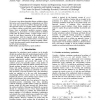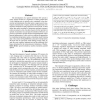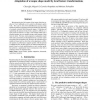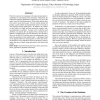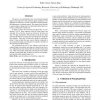INTERSPEECH
2010
13 years 6 months ago
2010
We present a new phone-dependent feature weighting scheme that can be used to map articulatory configurations (e.g. EMA) onto vocal tract spectra (e.g. MFCC) through table lookup....
INTERSPEECH
2010
13 years 6 months ago
2010
In this paper we present a method to predict the movement of a speaker's mouth from text input using hidden Markov models (HMM). We have used a corpus of human articulatory m...
INTERSPEECH
2010
13 years 6 months ago
2010
Automatic language identification (LID) systems generally exploit acoustic knowledge, possibly enriched by explicit language specific phonotactic or lexical constraints. This pape...
INTERSPEECH
2010
13 years 6 months ago
2010
The paper investigates a new method to solve concatenation problems of Mandarin speech synthesis which is based on the hybrid approach of HMM-based speech synthesis and unit selec...
INTERSPEECH
2010
13 years 6 months ago
2010
The amount of available Thai broadcast news transcribed text for training a language model is still very limited, comparing to other major languages. Since the construction of a b...
INTERSPEECH
2010
13 years 6 months ago
2010
The development of a speech translation (ST) system is costly, largely because it is expensive to collect parallel data. A new language pair is typically only considered in the af...
INTERSPEECH
2010
13 years 6 months ago
2010
Reconstructing the full contour of the tongue from the position of 3 to 4 landmarks on it is useful in articulatory speech work. This can be done with submillimetric accuracy usin...
INTERSPEECH
2010
13 years 6 months ago
2010
French is known to be a language with major pronunciation irregularities at word endings with consonants. Particularly, the well-known phonetic phenomenon called Liaison is one of...
INTERSPEECH
2010
13 years 6 months ago
2010
Our goal is to automatically learn a perceptually-optimal target cost function for a unit selection speech synthesiser. The approach we take here is to train a classifier on human...
INTERSPEECH
2010
13 years 6 months ago
2010
In this article, we propose an innovative way of estimating pitch from speech waveform data, using an iterative ARMA technique that efficiently estimates multiple frequency compon...
